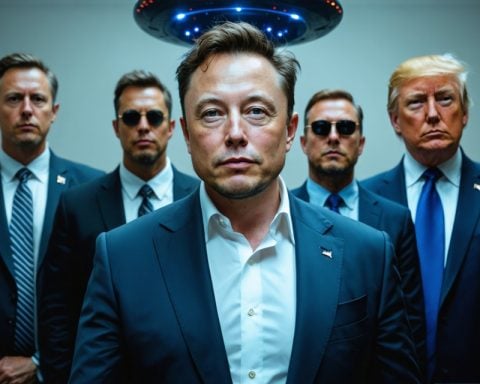Boosting Satellite Capabilities for 2025
The U.S. Space Force is gearing up for a monumental year in 2025, with astonishing forecasts of nearly $2.4 billion allocated for contracts involving various military branches and commands. This significant investment is aimed at enhancing satellite communication capabilities across the Department of Defense.
The Commercial Satellite Communications Office recently shared its projections for the upcoming fiscal period, identifying crucial needs that expand into fiscal 2026. In total, life cycle estimates from 18 important programs indicate that the overall budget could soar to $2.37 billion, reflecting a staggering 39.4% increase from last year’s forecast of about $1.7 billion.
At the forefront is the “Maneuverable GEO” initiative, envisioned as a commercial marketplace for mobile satellites in geosynchronous orbit. Officials expect to initiate contracts as early as July, potentially reaching $905 million in value.
Plans also feature the procurement of satellite bandwidth to enhance connectivity between vital bases in Greenland and Colorado, stressing the military’s reliance on commercial satellite services.
Each military branch is contributing to this operational expansion: from the Marine Corps seeking $550 million in satellite bandwidth to the Navy requiring $50 million for leadership aircraft. The Air Force aims to integrate commercial SATCOM solutions for its drone operations, while even the Coast Guard is looking to upgrade its aviation assets through these innovative satellite services.
This ambitious strategy demonstrates the Space Force’s commitment to modernizing America’s military communications landscape, blending both commercial and military capabilities.
Global Implications of Enhanced Satellite Capabilities
As the U.S. Space Force fortifies its satellite capabilities with a record budget, the ramifications extend far beyond military applications, reverberating throughout society, culture, and the global economy. The $2.4 billion investment highlights a pivotal shift where commercial satellite services are increasingly intertwined with national defense, signaling a broader trend towards public-private partnerships in technology. This collaboration promises to accelerate innovation, pushing the boundaries of what’s possible in communications and data transfer.
From a cultural perspective, improved satellite connectivity could enhance digital access across remote regions, breaking down barriers between geographies. With military efforts also aiming to enhance connectivity in bases, these advancements may inadvertently support civilian infrastructure and humanitarian initiatives. Improved communication during crises could translate to more effective disaster response, fostering societal resilience.
Environmentally, the push for satellite technologies prompts ongoing discussions about space debris and orbital sustainability. As satellite launches increase, the potential for congestion in space raises valid concerns over the long-term viability of our orbital environment. Thus, while the immediate benefits in communication and data relay are clear, sustainable practices in satellite deployment are paramount to mitigate ecological impacts.
Looking forward, the integration of satellite technologies in military operations signals a future where geosynchronous satellites could serve dual purposes—military and civilian—that reshape global engagement strategies. As nations recognize the significance of satellite infrastructure, we can expect increased investments in space technology, leading to a competitive landscape where both advancements and ethical considerations in space operations will be critically assessed.
The Future of Military Satellite Communications: What’s Next for 2025?
Boosting Satellite Capabilities for 2025
As the U.S. Space Force prepares for a transformative year in 2025, focus is intensifying on the significant investments aimed at upgrading satellite communication capabilities across various military branches. The projected budget of $2.4 billion is set to facilitate a host of contracts and enhance operations across the Department of Defense (DoD).
Key Features of the Strategic Investment
1. Maneuverable GEO Initiative:
This groundbreaking initiative is positioned as a commercial marketplace focused on mobile satellites in geosynchronous orbit. With anticipated contracts launching in July 2025, this program could reach $905 million, illustrating a shift towards leveraging commercial technologies in military operations.
2. Cross-Branch Collaboration:
Each military branch is mobilizing resources to improve their satellite capabilities:
– Marine Corps: Requesting $550 million for satellite bandwidth to enhance communication and operational effectiveness.
– Navy: Allocating $50 million for leadership aircraft, supporting strategic operations.
– Air Force: Aims to integrate commercial SATCOM innovations to bolster drone operations.
– Coast Guard: Enhancing their aviation capabilities through upgraded satellite services.
Trends in Satellite Procurement
The Commercial Satellite Communications Office has outlined substantial needs extending into fiscal 2026, reflecting an estimated overall budget of $2.37 billion, which marks a staggering 39.4% increase from the previous year’s forecast of $1.7 billion.
Use Cases and Limitations
– Enhanced Connectivity: The primary use case revolves around improving connectivity especially between crucial bases in Greenland and Colorado, indicating the military’s growing dependency on commercial satellite services.
– Limitations: Despite the ambitious plans, there are challenges, including budget constraints, potential delays in contract approvals, and the intricate logistics of integrating diverse satellite technologies.
Insights and Innovations
The fusion of commercial and military satellite capabilities indicates a broader trend toward leveraging private sector technology for military applications. As the Space Force modernizes its communication framework, this collaboration aims to enhance operational readiness and effectiveness on a global scale.
Security Aspects
Investments in satellite technology also carry implications for security. Increased reliance on commercial satellites enhances vulnerabilities, potentially exposing military communications to risks such as cyber threats. Ensuring robust security protocols is paramount as military operations evolve in sync with commercial technologies.
Pricing and Market Analysis
The market for satellite communication, particularly within the defense sector, is poised for growth. The significant budget allocations reflect a continuous commitment to expanding satellite capabilities, forecasting an evolving landscape of military communication that increasingly relies on advanced commercial solutions.
These advancements open a dialogue about the future of military communications, highlighting critical investments that could redefine operational strategies by 2025.
For more detailed insights into the U.S. Space Force and its initiatives, visit the Space Force official site.



















